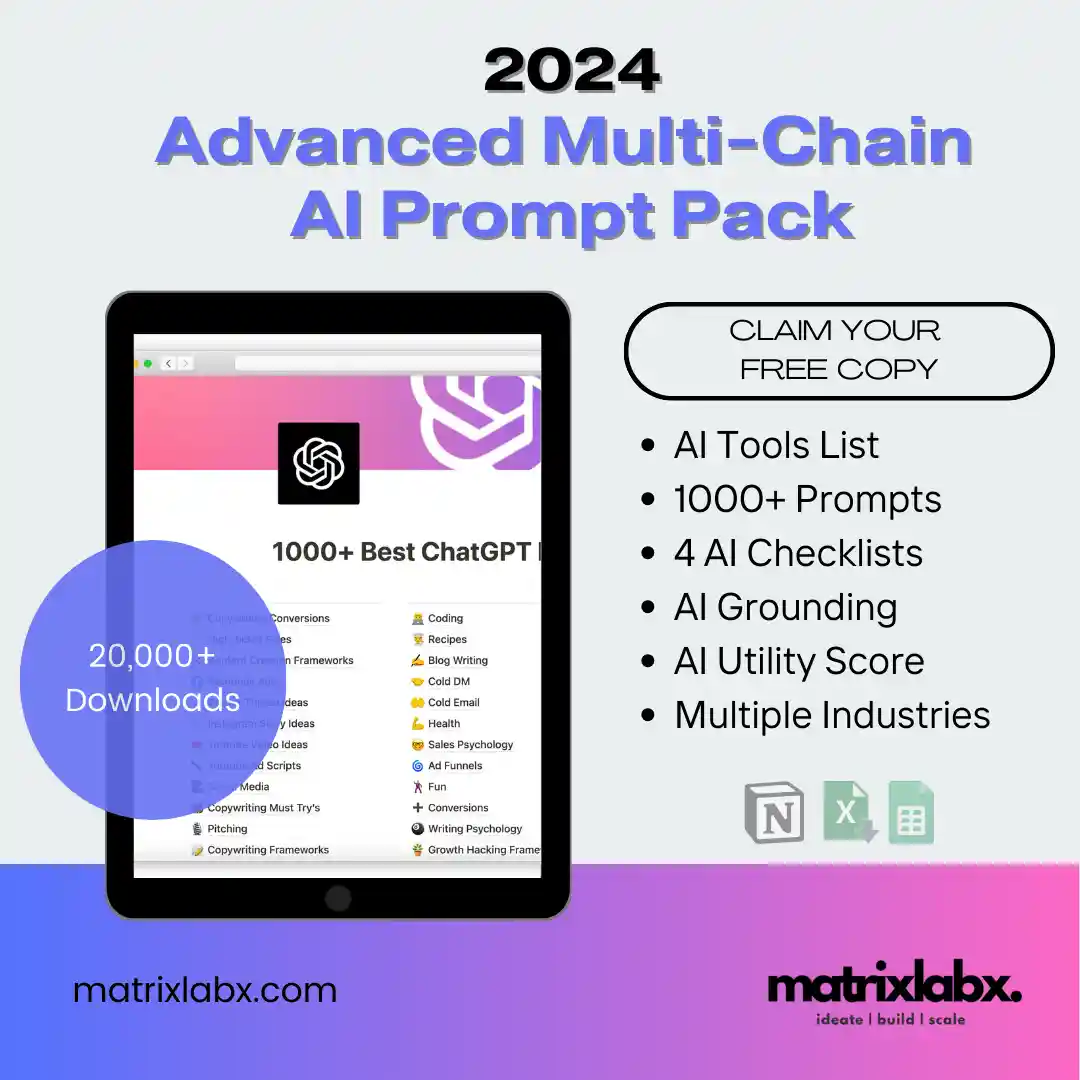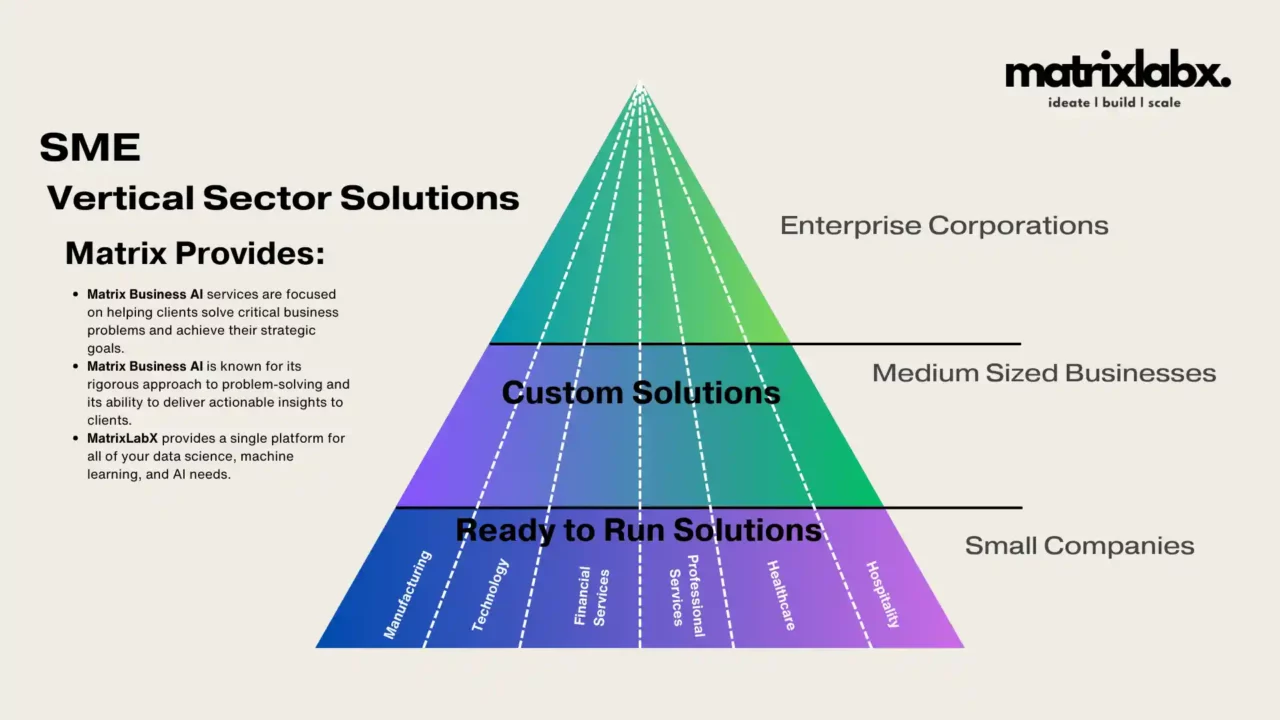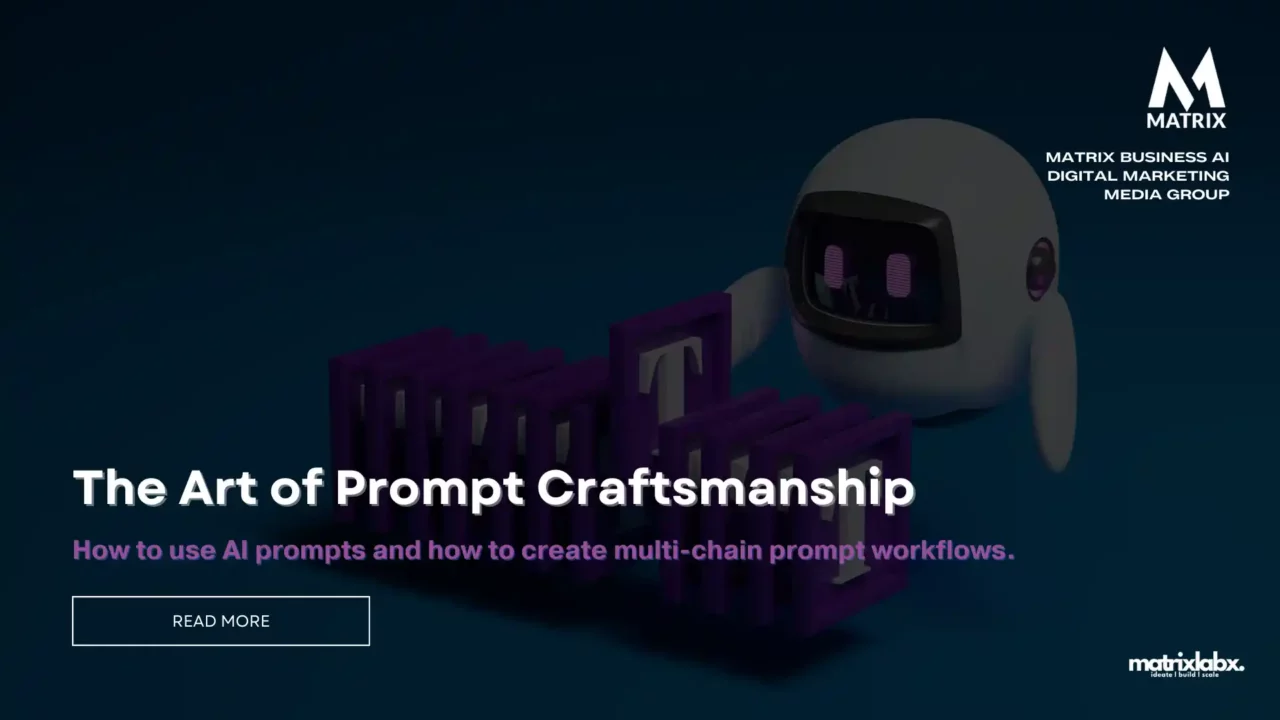AI prompts and how to create multichain prompt workflows
Learn how to use AI prompts and how to create multichain prompt workflows.
AI prompts are instructions or cues an AI model provides to guide its output.
They are like roadmaps that help the model understand what is expected of it and how to generate relevant and informative responses.
Effective, prompt writing is crucial for maximizing the capabilities of AI models and achieving desired outcomes.
Crafting Effective Prompts: The Art of Prompt Craftsmanship
Effective prompts amalgamate clarity, relevance, structure, and creativity. They are not just inquiries but catalysts for deeper exploration and understanding.
Encouraging Continuous Learning and Experimentation:
The journey of prompt craftsmanship is neverending. It demands continuous learning, adaptation, and experimentation, ensuring that each prompt is not just a question but a doorway to endless possibilities.
- Clarity and Specificity: Prompts should be clear, concise, and specific. Avoid vague or ambiguous language that could lead to misinterpretations or off-topic responses.
- Context and Background: Provide sufficient context and background information to help the model understand the task. This includes details about the topic, desired style, and relevant constraints.
- Examples and References: Provide examples or references to illustrate the desired output. This can help the model grasp the expected response’s style, tone, and format.
- Feedback and Iteration: Continuously refine prompts based on feedback from the AI model. Experiment with different phrasing, structure, and examples to improve the quality of the output.
Crafting Effective Prompts

Introduction to Prompt Crafting
Defining a Prompt:
A prompt is a catalyst, a meticulously worded inquiry or statement designed to elicit a response. Its application spans various domains, from education to AI technology, as a bridge between the inquirer and the respondent.
Importance in Various Contexts:
In the labyrinth of communication, prompts are the guiding lights. They facilitate deeper understanding, spark creativity, and are instrumental in education, therapy, technology, and creative writing.
The Anatomy of a Compelling Prompt

Core Components:
The essence of a compelling prompt lies in its clarity, relevance, and ability to engage. It should be a beacon, not a foghorn, directing the respondent clearly but gently.
Balancing Brevity and Descriptiveness:
Prompt crafting is a delicate balancing act between conciseness and detailed descriptiveness. It should be concise enough to maintain focus yet descriptive enough to inspire thought.
Understanding Your Audience and Profound Audience Segmentation
Demographic Considerations:
Knowing your audience is akin to understanding the terrain in a journey. Your audience’s age, background, and interests dramatically influence how you frame your prompt.
Tailoring Tone and Complexity:
The tone and complexity of your prompt should resonate with your audience’s intellect and emotional palette, forming a harmonious symphony rather than a discordant note.
Setting Clear Objectives

Identifying Desired Outcomes:
Each prompt should have a compass — a clear objective guiding its direction. Whether it’s to elicit an emotional response, provoke thought, or gather specific information, clarity in purpose is paramount.
Aligning Prompts with Goals:
The alignment of your prompt with your overarching goals ensures that each word serves a purpose, steering the response toward the intended destination.
Harnessing the Power of Open-Ended Questions
As an AI engineer, harnessing the power of open-ended questions is crucial for several reasons:
- Uncovering Hidden Insights: Open-ended questions allow AI models to explore uncharted territories of knowledge and uncover hidden insights that might not be readily apparent with closed-ended questions. By encouraging elaboration and providing a wider range of possibilities, open-ended questions can lead to unexpected discoveries and innovative solutions.
- Enhancing Creative Exploration: Open-ended questions foster creativity by prompting AI models to generate novel ideas, explore diverse perspectives, and synthesize information from various sources. This ability to think outside the box and approach problems in unconventional ways is essential for breakthroughs in fields like art, design, and problem-solving.
- Promoting Deeper Understanding: Open-ended questions encourage AI models to delve deeper into concepts, investigate underlying causes, and consider multiple viewpoints. This thorough investigation fosters a more comprehensive understanding of complex topics and enables AI models to provide more nuanced and insightful responses.
- Adapting to Unforeseen Circumstances: Open-ended questions give AI models the flexibility to adapt to unforeseen circumstances and handle unexpected situations. Open-ended questions prepare AI models for the real-world complexities they may encounter by encouraging the exploration of different scenarios and potential outcomes.
- Facilitating Human-AI Collaboration: Open-ended questions bridge human experts and AI models, enabling effective collaboration and knowledge exchange. Open-ended questions foster a synergistic partnership between human intuition and AI’s computational power by providing a common framework for exploration and discovery.
We can help you begin harnessing the power of open-ended questions, which is essential for AI engineers to unlock the full potential of AI models. By empowering AI to explore, create, and understand with greater depth and flexibility, open-ended questions pave the way for groundbreaking discoveries, innovative solutions, and a deeper understanding of the world around us.
Encouraging Creativity and Depth:
Open-ended questions are the keys that unlock the treasure troves of creativity and depth in responses. They invite explorers rather than tourists into the realm of thought.
Avoiding Overly Broad or Vague Questions:
However, beware of the siren song of vagueness. Too broad a question can lead to aimless wandering in the desert of thought.
Incorporating Specificity and Relevance

Using Concrete Details:
Integrating concrete details in your prompts acts as anchors, grounding the respondent’s thoughts and providing a clear direction for their response.
Relating to the Audience’s Interests and Needs:
The relevance of your prompt to your audience’s interests and needs cannot be overstated. It should speak to them, echoing their curiosities and concerns.
Structuring for Clarity and Impact
Logical Flow and Coherence:
A well-structured prompt flows like a river, each word and phrase seamlessly leading to the next, ensuring coherence and clarity.
The Role of Syntax and Diction:
Your prompt’s choice of words (diction) and their arrangement (syntax) can significantly affect its impact. These elements should be wielded with precision and care.
Utilizing Hypothetical Scenarios
Engaging the Imagination:
Hypothetical scenarios in prompts act as portals to imaginary worlds, engaging the respondent’s imagination and facilitating creative responses.
Applying RealWorld Contexts:
When rooted in real-world contexts, these scenarios can provide practical insights and solutions, bridging the gap between imagination and reality.
Are Your Marketing Efforts a Shot in the Dark? Let’s Turn on the Spotlight!
Imagine having the clarity of seeing your marketing strategy from a bird’ s-eye view and understanding every nuance of your campaigns. Our comprehensive audit delves into the core of your marketing DNA, dissecting each campaign with surgical precision to identify the powerhouse strategies and weed out the underperformers.

Testing and Refining Prompts
Testing and refining prompts is an iterative process that involves evaluating the performance of a prompt, identifying areas for improvement, and making adjustments to optimize the output.
Here’s a step-by-step guide on how to test and refine prompts as an AI engineer:
- Define the task and desired outcomes: Clearly define the task the prompt is intended for and the specific outcomes you want to achieve. This will help you focus your evaluation and refinement efforts.
- Baseline evaluation: Evaluate the initial prompt using a representative set of inputs. Observe the model’s responses and identify patterns, biases, or inconsistencies.
- Identify areas for improvement: Analyze the baseline evaluation results and pinpoint areas where the prompt can be improved to align with the desired outcomes.
- Hypothesize refinements: Formulate hypotheses about how to refine the prompt to address the identified areas for improvement. These hypotheses can involve adjusting the prompt’s wording, structure, or context.
- Test refined prompts: Test the refined prompts using the same set of inputs as the baseline evaluation. Observe the changes in the model’s responses and compare them to the initial results.
- Evaluate and iterate: Evaluate the performance of the refined prompts and compare them to the baseline results. If the refinements have improved the outcomes, adopt the changes. If not, formulate new hypotheses and repeat the testing cycle.
- Continuous refinement: Prompt refinement is an ongoing process. As the AI model evolves and the task requirements change, continue to evaluate and refine prompts to ensure they can effectively achieve the desired outcomes.
Here are some additional tips for testing and refining prompts:
- Use a variety of inputs: Test the prompt with various inputs that represent the expected range of data or scenarios. This will help identify potential biases or limitations in the prompt.
- Use multiple evaluation metrics: Employ multiple metrics to assess the prompt’s performance, such as accuracy, relevance, coherence, and creativity. This will provide a more comprehensive understanding of the prompt’s effectiveness.
- Seek human feedback: Involve human experts in the evaluation process to provide insights the AI model may overlook. This can help identify subtle nuances or biases impacting the prompt’s performance.
- Document the process: Document the testing and refinement process, including the initial prompt, hypothesized refinements, test results, and evaluation metrics. This documentation will be valuable for future reference and improvement.
MultiChain Prompt Workflows

Multichain prompt workflows involve connecting multiple prompts in a sequence to guide the AI model through a complex task or process.
Each prompt builds upon the previous one, gradually refining the output and steering the model towards the desired outcome.
AI engineers should know about multichain prompt workflows because they are a powerful tool for guiding AI models through complex tasks and achieving desired outcomes. Multichain prompt workflows allow AI engineers to break down complex tasks into smaller, more manageable subtasks and then create individual prompts for each subtask. This helps to ensure that the AI model understands the task at hand and can generate relevant and informative responses.
Here are some of the specific benefits of using multichain prompt workflows:
- Improved task understanding: AI engineers can better convey the task requirements to the AI model by breaking a task into smaller subtasks. This can lead to more accurate and relevant outputs.
- Enhanced creativity: Multichain prompt workflows can guide AI models through creative processes, such as writing, design, and problem-solving. This can help to generate new and innovative ideas.
- Efficient knowledge extraction: Multichain prompt workflows can extract insights from complex data sources by breaking down the process into data cleaning, pattern identification, and interpretation.
- Effective error detection and correction: By providing clear and specific instructions, multichain prompt workflows can help to reduce the risk of errors in the AI model’s output.
In addition to these benefits, multichain prompt workflows are becoming increasingly important as AI models become more complex and capable.
By using multichain prompt workflows, AI engineers can effectively harness the power of these models to solve real-world problems and achieve a wide range of goals.
Here are some specific examples of how AI engineers can use multichain prompt workflows in their work:
- Generating comprehensive and informative content: AI engineers can use multichain prompt workflows to guide AI models through content generation, from outlining to drafting to editing.
- Extracting insights from complex data sources: AI engineers can use multichain prompt workflows to extract insights from complex data sources, such as financial data, medical data, or social media data.
- Developing creative solutions to complex problems: AI engineers can use multichain prompt workflows to guide AI models through creative problem-solving, from idea generation to concept evaluation to refinement.
As AI technology evolves, multichain prompt workflows will likely become even more important. AI engineers who are familiar with and skilled in multichain prompt workflows will be well-positioned to take advantage of the latest advances in AI and use these models to solve problems, create new possibilities, and drive innovation.
Creating Multi-Chain Prompt Workflows
Creating a multichain prompt workflow for healthcare involves a sequence of steps designed to collect, process, analyze, and respond to information across various data sources and services. Here’s a step-by-step guide to set this up:
1. Define Your Objectives and Scope
- Identify the healthcare areas you want to focus on (e.g., patient data collection, diagnostics, treatment planning).
- Determine the goals of your workflow (e.g., improving patient care, streamlining data processing).
2. Identify Data Sources
- List all potential data sources (e.g., electronic health records, wearable health devices, lab results).
- Ensure compliance with healthcare data privacy laws like HIPAA or GDPR.
3. Design the Workflow Structure
- Map out the workflow, indicating how data flows from one stage to another.
- Identify where human intervention is required and where automation can be applied.
4. Select and Integrate Technologies
- Choose appropriate technologies for each step (e.g., AI for data analysis, blockchain for secure data transfer).
- Ensure the technologies are interoperable and can effectively communicate with each other.
5. Develop Data Processing Protocols
- Establish rules for data validation, cleaning, and transformation.
- Implement algorithms for data analysis, like machine learning models for predictive analytics.
6. Implement MultiChain Prompt Workflows
- Develop prompts for each step of the workflow.
- Ensure prompts are clear, concise, and designed to elicit the necessary data or action.
7. Test the Workflow
- Conduct thorough testing to ensure each component functions as intended.
- Perform end-to-end testing to evaluate the entire workflow’s performance.
8. Deploy and Monitor
- Roll out the workflow in a controlled environment.
- Continuously monitor the workflow for any issues and gather feedback for improvements.
9. Ensure Security and Compliance
- Implement robust security measures to protect sensitive healthcare data.
- Regularly update the system to comply with evolving healthcare regulations.
10. Iterate and Improve
- Analyze the performance and gather feedback from users.
- Make necessary adjustments and updates to improve efficiency and effectiveness.
Important Considerations:
- User Training: Ensure all healthcare staff are adequately trained to use the new system.
- Patient Engagement: Consider how this workflow impacts patient experience and care.
- Ethical Implications: Regularly assess the ethical implications of using automated systems in healthcare.
This guide provides a general framework, but the specifics may vary depending on the healthcare domain and the technologies involved.
- Task Decomposition: Break the overall task into smaller, more manageable subtasks. Each subtask should represent a distinct step in the process.
- Individual Prompts: Craft individual prompts for each subtask. Ensure each prompt defines the specific task clearly and provides relevant context and instructions.
- Prompt Chaining: Connect the prompts in a logical sequence, ensuring the output of one prompt feeds into the input of the next. This creates a seamless workflow that guides the model through the entire process.
- Feedback and Refinement: Iterate on the prompt chain, providing feedback and refining prompts as needed. This ensures the workflow effectively addresses the task and produces the desired outcome.
Applications of MultiChain Prompt Workflows
- Content Generation: Generate comprehensive and informative content by breaking down the writing process into subtasks, such as outlining, drafting, and editing.
- Knowledge Extraction: Extract insights from complex data sources by dividing the process into steps like data cleaning, pattern identification, and interpretation.
- Creative Problem Solving: Approach creative challenges by structuring the process with prompts that guide idea generation, concept evaluation, and refinement.
AI prompts and multichain prompt workflows are powerful tools for unlocking the potential of AI models.
By effectively crafting prompts and connecting them in a structured manner, users can guide AI models through complex tasks, generate creative outputs, and extract valuable insights from data.
As AI technology continues to evolve, the role of prompts will become increasingly important in harnessing the power of these models to solve problems, create new possibilities, and drive innovation.
Iterative Improvement Process:
The process of refining prompts is continuous and iterative. Each iteration hones its effectiveness, sharpening it into a tool of precision.
Creating Multi-Chain Prompt Workflows to Enhance Customer Experience for a $50 Million Technology Firm

A $50 million technology firm seeking to elevate customer experience can effectively utilize multi-chain prompt workflows to guide AI models through identifying and addressing customer pain points, enhancing satisfaction, and fostering loyalty.
Step 1: Define Customer Experience Objectives
Begin by clearly defining the specific objectives for enhancing customer experience. This may include:
- Reducing customer churn rate
- Increasing customer satisfaction ratings
- Identifying and resolving customer pain points
- Improving customer engagement and loyalty
Step 2: Gather Customer Feedback
Collect customer feedback through various channels, such as surveys, reviews, social media, and customer service interactions. Analyze this feedback to identify common themes, recurring issues, and areas for improvement.
Step 3: Break Down the Customer Experience Journey
Break the customer experience journey into distinct stages, from initial awareness to post-purchase interactions. Identify touchpoints where customer interactions occur and where pain points might arise.
Step 4: Create Individual Prompts for Each Stage
Develop individual prompts for each stage of the customer experience journey. These prompts should guide the AI model to analyze customer feedback, identify pain points, and suggest potential solutions.
Stage 1: Initial Awareness
- Prompt: Analyze customer feedback to identify how customers initially discover and learn about our products or services.
- Prompt: Identify common misconceptions or barriers hindering customers from exploring our offerings.
Stage 2: Research and Consideration
- Prompt: Analyze customer feedback to understand how customers evaluate and compare different options before purchasing.
- Prompt: Identify any gaps in product information or support resources that may hinder customer decision-making.
Stage 3: Purchase
- Prompt: Analyze customer feedback to understand the purchasing process, identifying any pain points or friction points.
- Prompt: Suggest improvements to streamline the checkout process, enhance payment options, and provide clear order confirmations.
Stage 4: Onboarding and Usage
- Prompt: Analyze customer feedback to identify any challenges or frustrations encountered during product setup or initial usage.
- Prompt: Suggest improvements to onboarding materials, tutorials, or in-app guidance to enhance the user experience.
Stage 5: Ongoing Engagement and Support
- Prompt: Analyze customer feedback to understand how customers interact with our support channels and resolve issues.
- Prompt: Identify areas where support interactions can be more efficient, personalized, and effective.
Step 5: Connect Prompts into a Multi-Chain Workflow
Sequence the individual prompts into a cohesive multi-chain workflow, ensuring that each prompt builds upon the output of the previous one.
This will guide the AI model through a comprehensive analysis of the customer experience journey.
Step 6: Test and Refine the Multi-Chain Workflow
Test the multi-chain prompt workflow using a representative sample of customer feedback.
Evaluate the AI model’s responses and refine prompts to ensure they accurately reflect customer experiences and generate actionable insights.
Step 7: Implement and Monitor Results
Implement the refined multi-chain prompt workflow into the AI-driven customer experience analysis process. Continuously monitor the results, evaluating the impact on customer satisfaction, churn rate, and other key metrics.
Step 8: Iterate and Improve
Regularly review and iterate on the multi-chain prompt workflow based on new customer feedback, evolving customer needs, and emerging trends. This continuous improvement will ensure that AI models remain effective in identifying and addressing customer pain points, enhancing satisfaction, and fostering loyalty.
Are Your Marketing Efforts a Shot in the Dark? Let’s Turn on the Spotlight!
Imagine having the clarity of seeing your marketing strategy from a bird’ s-eye view and understanding every nuance of your campaigns. Our comprehensive audit delves into the core of your marketing DNA, dissecting each campaign with surgical precision to identify the powerhouse strategies and weed out the underperformers.

Conclusion
Multi-chain prompt workflows are a powerful tool for new AI engineers to harness the potential of AI models and address complex challenges. By breaking down tasks into smaller subtasks and providing clear instructions, multi-chain prompt workflows guide AI models through intricate processes, fostering creativity, enabling deeper understanding, and promoting adaptation to unforeseen circumstances.
To effectively create multi-chain prompt workflows, new AI engineers should follow a structured approach:
- Define Clear Objectives: Clearly define the specific goals and objectives of the task, ensuring the AI model understands the desired outcomes.
- Break Down Tasks into Subtasks: Divide the complex task into smaller, more manageable subtasks, creating a clear roadmap for the AI model to follow.
- Craft Individual Prompts: For each subtask, craft a prompt with detailed instructions, relevant context, and examples.
- Sequence Prompts into a Workflow: Connect the individual prompts into a logical sequence, ensuring the AI model’s output from one prompt feeds into the next.
- Test and Refine: Test the multi-chain prompt workflow with representative input data, evaluating the model’s responses and refining prompts as needed.
- Iterate and Improve: Continuously review and improve the multi-chain prompt workflow based on feedback, new data, and evolving task requirements.
By mastering the art of multi-chain prompt workflows, new AI engineers can harness the power of AI models to tackle complex challenges, generate creative solutions, and uncover hidden insights. This skill will be instrumental in their journey to become proficient AI engineers capable of shaping the future of AI-driven innovation.
Regularly review and iterate on the multi-chain prompt workflow based on new customer feedback, evolving customer needs, and emerging trends. This continuous improvement will ensure that AI models remain effective in identifying and addressing customer pain points, enhancing satisfaction, and fostering loyalty.

